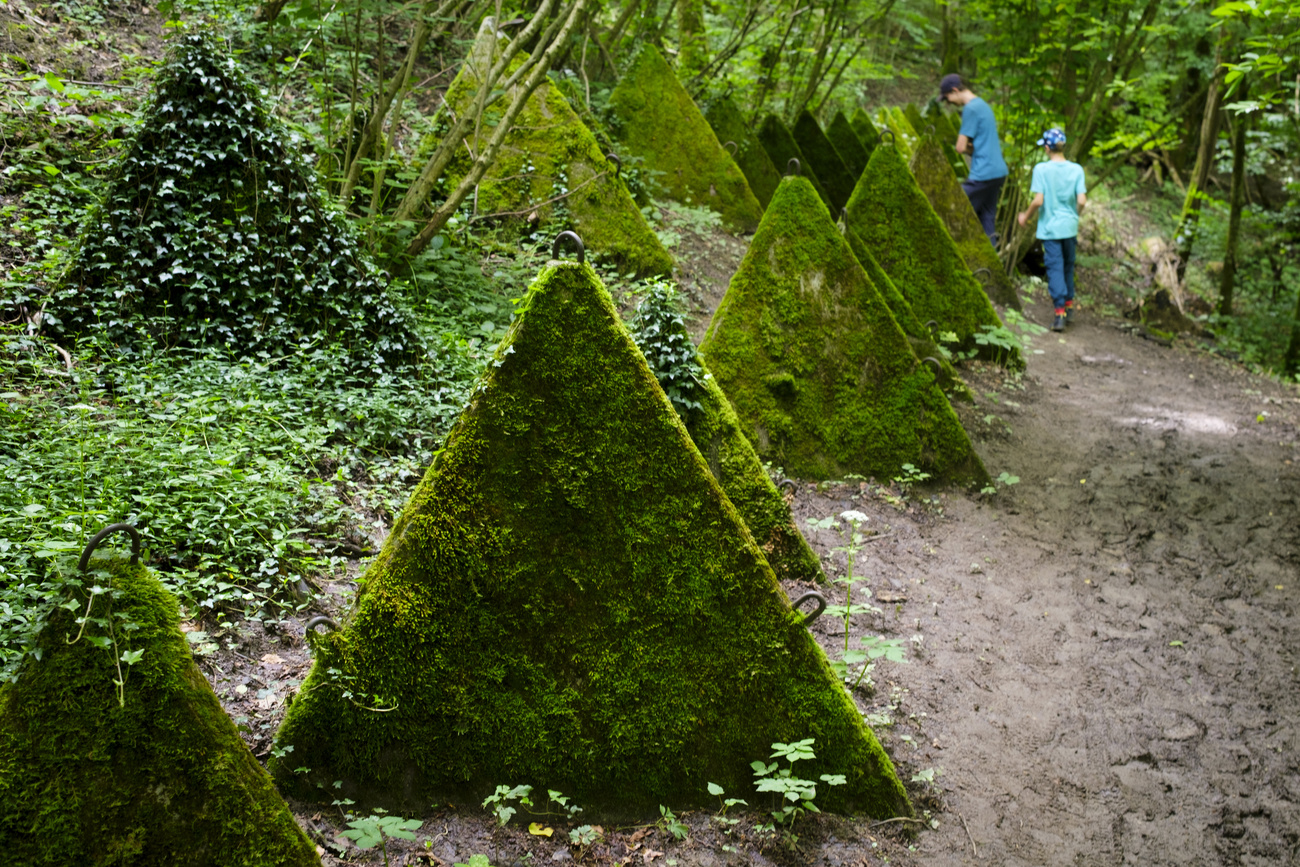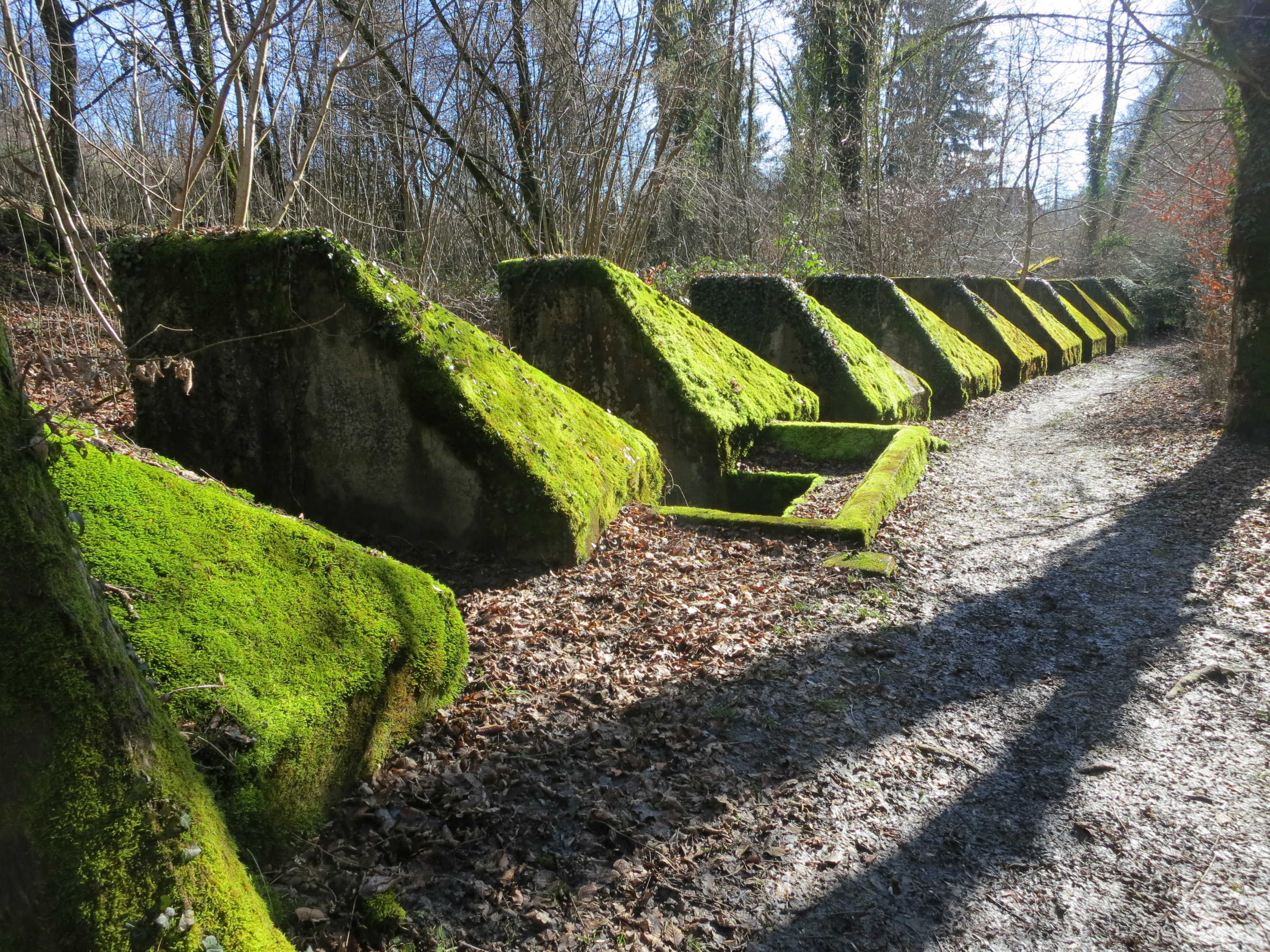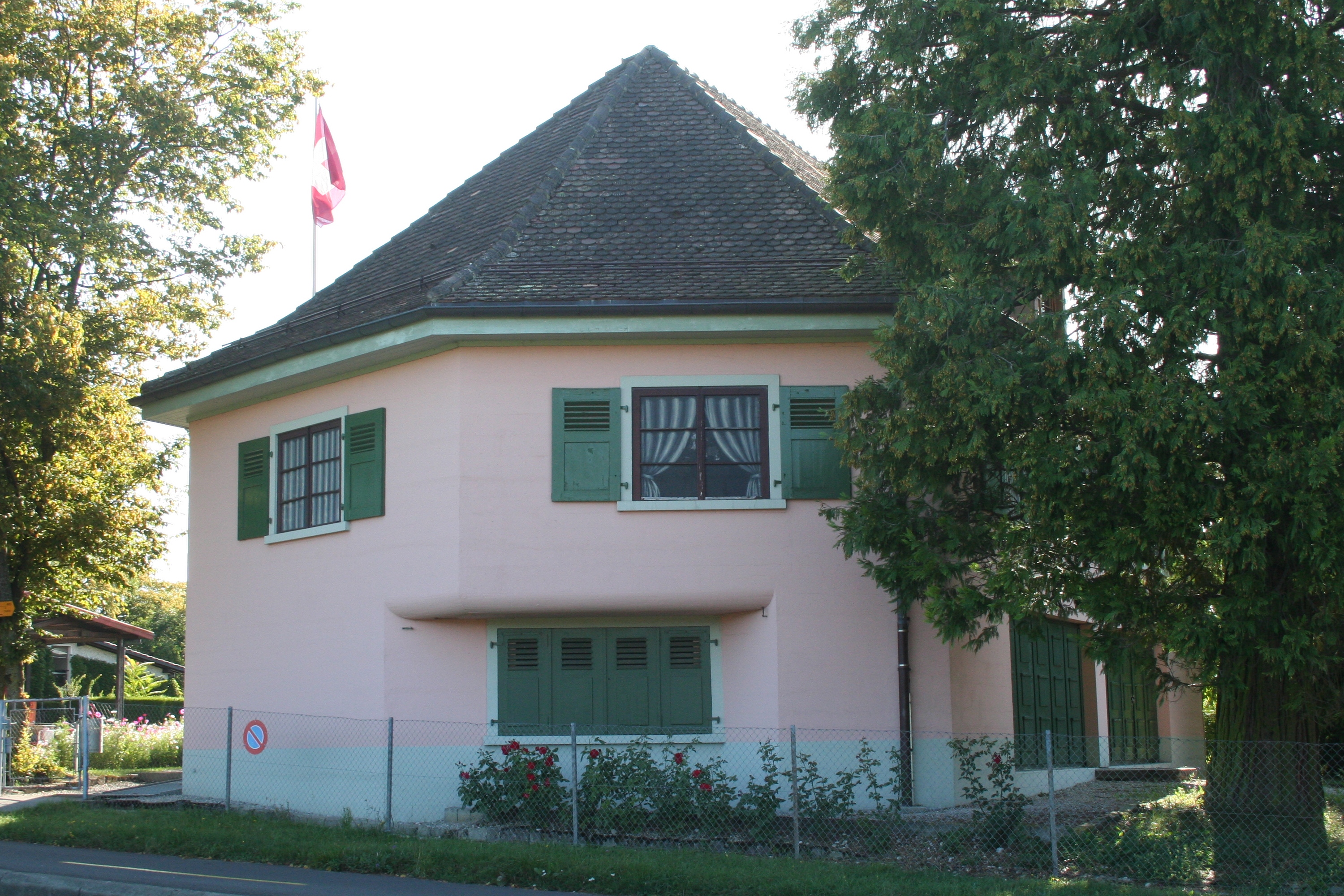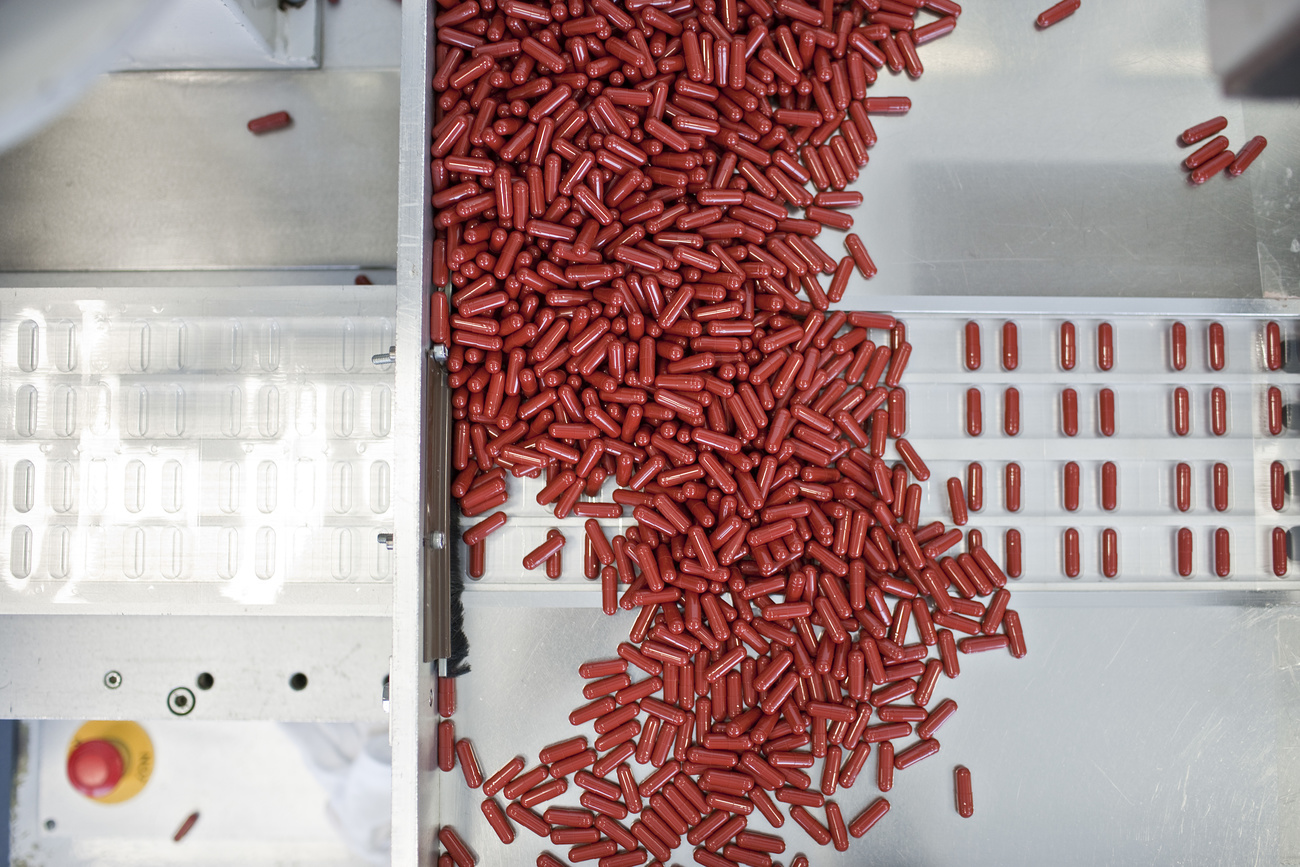
The Toblerone Trail: a unique walk through Swiss history and nature

The Toblerone Trail, which winds from the forests of the Jura mountains in western Switzerland down to the shores of Lake Geneva, is a reminder of an important part of Switzerland’s war-time heritage. It’s also a wonderful hike through nature.
“There’s no chocolate along the Toblerone Trail,” points out outdoor activity platform SwitzerlandMobilityExternal link, perhaps anticipating complaints from disappointed parents. “It’s actually an educational route that focuses on history, following a defensive line set up in the Second World War.”
The toblerones in question – some 3,000 of them – are massive concrete pyramids, also known as “dragon’s teeth”, built to stop German tanks invading from France.
These blocks, which are up to two metres tall and can weigh 15 tonnes, popped up all over Switzerland during the war, but the ten-kilometre line from Bassins, in the Jura mountains, running south to the lakeside near Prangins, is the best-preserved section.

Toblerones or dragon’s teeth are not the only anti-tank defences: others include the Czech hedgehog and the Belgian gate.
Rows of dragon’s teeth were used by several armies during the Second World War. The Germans made extensive use of them on the Siegfried Line and the Atlantic Wall.
Dragon’s teeth are still present in some areas along the borders of the Korean Demilitarized Zone.
In November 2022, Russia started constructing dragon’s teeth around the occupied Ukrainian city of Mariupol, according to Ukrainian journalistsExternal link who cited the UK Ministry of Defence.
“Around 1940, when German troops were attacking neutral countries such as Belgium and Norway, fears also reached very high levels in Switzerland,” SwitzerlandMobility explains.
“This prompted the start of construction work on the ‘Promenthouse Defence Line’: chunks of concrete were set up one after another along the courses of rivers and streams. Instead of removing them again, some were restored as a reminder of the war’s importance for Switzerland.”
Here is a gallery of toblerones found elsewhere around Switzerland:
The full Toblerone Trail, between Bassins and Nyon, is about 18km and can be done in half a day; the shady forest sections along three brooks (the Promenthouse, the Combe and the Serine) are particularly pleasant in summer. The landscape also includes vineyards, orchards and cornfields and, down by the lake, magnificent views of Mont Blanc. The toblerones used to extend 50 metres into Lake Geneva, to prevent an amphibious assault on Switzerland.
‘Richer than a zoo!’
The Toblerone Trail AssociationExternal link (formally the Promenthouse Fortified Line Association) has cleared a well-marked path through the undergrowth and farmland from Bassins to Nyon, as well as putting in steps and bridges. Several entertaining information panels explain the role of the forest, the tree species and the historic elements of this strategic fortification.
The association says the project started as an attempt to preserve an important part of Swiss military heritage, but it soon realised that the environmental aspect was just as important.
The concrete blocks, many of them now covered in moss, ivy and brambles, provide an ideal home for many animals and species of plant. “The site is much richer than a zoo!” the association says.
What can stop tanks can certainly stops tractors. “The massive tank traps tend to prevent intensive cultivation of the land, so they are now wreathed in moss and ivy – a welcoming habitat for many plants and animals,” says SwitzerlandMobility. “Birds chirrup along the streams and above the canopy of greenery. From the fields, you can admire the views of Lake Geneva and the French Alps.”
“Fauna is much more difficult to approach than flora, for one obvious reason: its mobility,” the Toblerone Trail Association helpfully explains, adding that “the company of a dog is hardly favourable”.
It points out that many animals are nocturnal – “hedgehogs, badgers, weasels, beavers, field mice, shrews, not to mention bats, half a dozen species of which could be found in the region” – but there is plenty for the trained, and patient, eye and ear to see and hear. At the smaller end of the scale, there is no shortage of arthropods, such as insects, spiders and millipedes.
But while most bigger mammals go unnoticed, “the same can’t be said of birds”. There are almost 100 breeding species, from tiny kinglets and wrens to the majestic grey heron. Some species are strictly confined to streams (dippers, wagtails, kingfishers), while others rarely leave the foliage (warblers). Others tend to frequent the meadows (crows, larks, yellowhammers). Some birds do not fear the proximity of houses (black redstarts, house sparrows, swallows, swifts). Finally, some species can only be seen or heard in the forests near the lake (orioles, nightingales).
As for flora, “let’s say straight away that the vegetation bordering the Toblerone Trail is not exceptional,” the association website says with admirable honesty. “[The plants] can be found everywhere in the region and especially at the edge of rivers.” However, it is “no less interesting” and offers multiple observation possibilities “for the curious walker as for teachers and students”.
(Source: Toblerone Trail AssociationExternal link)
The main objective, however, is educational: to ensure that this unique piece of military heritage is preserved for future generations. The Toblerone Trail Association gives teachers background information about the military history, geology and ecology of the walk before they bring school trips.
Villa Rose
So why was the defensive line built here? Why not on the Swiss border?
The Promenthouse-Serine valley was the first natural barrier that an army invading from the west would encounter. Geneva, surrounded on three sides by occupied France, would have been almost impossible to defend. So the toblerones were built here – by soldiers and the unemployed – on land given up by many locals to support the war effort.
However, the toblerones are not the only surprise – for Germans then, for hikers now – along the route.
Villa RoseExternal link is a pretty pink house on what used to be the main road between Geneva and Bern. For decades it puzzled locals: it was clearly well maintained, but there was never a light in the windows and no one was ever spotted coming or going.

However, older people who were part of the war mobilisation knew that it was in fact an impregnable fortress whose walls are 2.5m thick and whose window slits are reinforced by 10cm steel plates. The windows are fake – they have just been painted on.
Villa Rose is one of 12 pillboxesExternal link – camouflaged concrete guard-posts with loopholes through which weapons can be fired – built along the Toblerone Trail. During the war it was bursting with weapons and ammunition and was home to up to 25 soldiers, linked to the outside world via a military telephone, who would stay there for weeks at a time, fingers on triggers, waiting for the Germans to invade.
The Toblerone Trail defensive line and its bunkers are on the list of objects of national importanceExternal link.
Edited by Samuel Jaberg/gw

More
Villa Rose opens doors to Toblerone ramblers

More
Toblerone can afford to abandon the Matterhorn
More

In compliance with the JTI standards
More: SWI swissinfo.ch certified by the Journalism Trust Initiative










































You can find an overview of ongoing debates with our journalists here . Please join us!
If you want to start a conversation about a topic raised in this article or want to report factual errors, email us at english@swissinfo.ch.